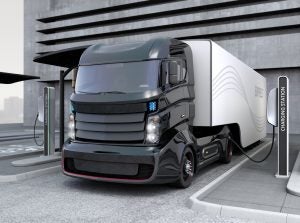These 4 trends prove electric trucks and buses are revving up
 To avoid the worst impacts of climate change, we’ll need to accelerate electrification of the fastest growing source of greenhouse gases in the world: medium- and heavy-duty vehicles. These include vehicles from big semitrucks and delivery vans, to city buses and garbage trucks.
To avoid the worst impacts of climate change, we’ll need to accelerate electrification of the fastest growing source of greenhouse gases in the world: medium- and heavy-duty vehicles. These include vehicles from big semitrucks and delivery vans, to city buses and garbage trucks.
Fortunately, this sector looks poised to grow through 2020 and beyond, good news for the climate and the millions of people who live in cities, where trucks and buses are leading contributors to local air pollution.
Here are four trends that I’ll be monitoring in the year ahead.
E-truck options continue to increase
Availability has long been a hurdle for fleet owners considering electrification. But as the year progresses, fleets will have access to an increasing range of electric vehicles from a number of manufacturers. Truck applications that are likely to see more EV choices include:
- Local delivery and box trucks Peterbilt and Dana, for example, recently showcased a Peterbilt Model 220EV that will have up to 200 miles of range. The vehicle is slated for production in late 2020. Navistar also is readying a medium-duty EV under its International label. The manufacturer is promising “250 miles on a single charge” with a 312 kWh battery and full production by early 2021.
- Garbage trucks There are over 100,000 garbage trucks operating in the U.S., and most run on diesel. Their low-speed, stop-and-go operations with predictable routes are an ideal fit with EV technology. Mack, Peterbilt and Daimler have all recently promoted their development of electric garbage trucks, and BYD already has trucks in the space, including some operating in Seattle.
- Mid-range freight trucks Volvo has already launched pilots of its electric regional tractor. The vehicle is scheduled to go into production in late 2020. Daimler also has active pilots of its eCascadia, a vehicle that it has slated for production in 2021.
Manufacturers accelerate investments in zero-emission trucks
As they have come to the conclusion that zero emission is the future of transportation, manufacturers have begun investing large amounts of capital to develop more zero-emission trucks and buses.
This trend emerged in 2018, when Daimler announced an investment of more than $3 billion for research and development of commercial electric trucks, including a $155 million investment in Proterra. Over the past year, we saw more manufacturers getting into the game:
- Cummins acquired a fuel cell company.
- Navistar launched an entire business unit dedicated to developing electric trucks.
- Daimler acquired a stake in battery material innovator Sila Nano.
Daimler further committed to a zero-emission future when it dumped its bid to develop natural gas trucks.
Fleets double down on e-buses and trucks
Fleets made a number of notable commitments in 2019, but with New Jersey Transit setting a date for procurement of an all zero-emission bus fleet, and Los Angeles’ LA Sanitation committing to a 100% electric fleet by 2035, 2020 is off to a good start, too.
These actions follow previous commitments by New York’s MTA, Anheuser Busch and Amazon. In 2019, Amazon announced that it would purchase 100,000 electric delivery vehicles.
As more vehicles become available and more fleets gain experience with zero-emission options, we’ll see more fleets setting zero-emission vehicle adoption targets and timetables for going 100% clean.
Policy drivers strengthen and expand
Public policy will continue to significantly impact the pace of adoption for zero-emission trucks. California, already a leader in e-truck deployment due to its significant investment in incentive programs, is expected to finalize its Advance Clean Truck program in 2020.
Other states are looking to reduce emissions from trucks and buses. In December, eight states announced their commitment to develop an action plan that will put hundreds of thousands more zero-emission trucks and buses onto their streets.
Demand for action is also strong at the local level. 34 cities worldwide — including London and Los Angeles — recently committed to ensuring a major area of each city is zero emission by 2030, and to procure only zero-emission buses from 2025. We believe this trend of creating ‘fossil fuel-free zones’ in cities is growing.
These four trends support each other and create a positive feedback cycle. As more vehicle options become available, fleets will increase their level of comfort with the technology, attracting further manufacturer investments and inspiring bolder policy action.
At EDF, we’re working with manufacturers, fleets, utilities and other stakeholders to spark the global transition to electric transportation. We’re starting with the United States, Europe and China, where we aim to have at least 30% of new trucks and buses sold be electric by 2030.
In the meantime, 2020 will be another important year for electric trucks and buses, kicking off a decade of advancement that will firmly establish these vehicles as the workhorses of the 21st century.










